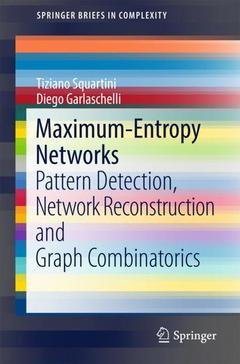Maximum-Entropy Networks, 1st ed. 2017 Pattern Detection, Network Reconstruction and Graph Combinatorics SpringerBriefs in Complexity Series
Langue : Anglais
Auteurs : Squartini Tiziano, Garlaschelli Diego

This book is an introduction to maximum-entropy models of random graphs with given topological properties and their applications. Its original contribution is the reformulation of many seemingly different problems in the study of both real networks and graph theory within the unified framework of maximum entropy. Particular emphasis is put on the detection of structural patterns in real networks, on the reconstruction of the properties of networks from partial information, and on the enumeration and sampling of graphs with given properties.
After a first introductory chapter explaining the motivation, focus, aim and message of the book, chapter 2 introduces the formal construction of maximum-entropy ensembles of graphs with local topological constraints. Chapter 3 focuses on the problem of pattern detection in real networks and provides a powerful way to disentangle nontrivial higher-order structural features from those that can be traced back to simpler local constraints. Chapter 4 focuses on the problem of network reconstruction and introduces various advanced techniques to reliably infer the topology of a network from partial local information. Chapter 5 is devoted to the reformulation of certain ?hard? combinatorial operations, such as the enumeration and unbiased sampling of graphs with given constraints, within a ?softened? maximum-entropy framework. A final chapter offers various overarching remarks and take-home messages.
By requiring no prior knowledge of network theory, the book targets a broad audience ranging from PhD students approaching these topics for the first time to senior researchers interested in the application of advanced network techniques to their field.
Introduction.- Maximum-entropy ensembles of graphs.- Constructing constrained graph ensembles: why and how?.- Comparing models obtained from different constraints.- Pattern detection.- Detecting assortativity and clustering.- Detecting dyadic motifs.- Detecting triadic motifs.- Some extensions to weighted networks.- Network reconstruction.- Reconstructing network properties from partial information.- The Enhanced Configuration Model.- Further reducing the observational requirements.- Graph combinatorics.- A dual route to combinatorics?.- ‘Soft’ combinatorial enumeration.- Quantifying ensemble (non)equivalence.- Breaking of equivalence between ensembles.- Implications of (non)equivalence for combinatorics.- “What then shall we choose?” Hardness or softness?.- Concluding remarks.
A complete self-consistent introduction to a general methodology to study complex networks
Emphasizes the connections between pattern detection, network reconstruction and graph combinatorics
Includes supplementary material: sn.pub/extras
Date de parution : 11-2017
Ouvrage de 116 p.
15.5x23.5 cm
© 2024 LAVOISIER S.A.S.



